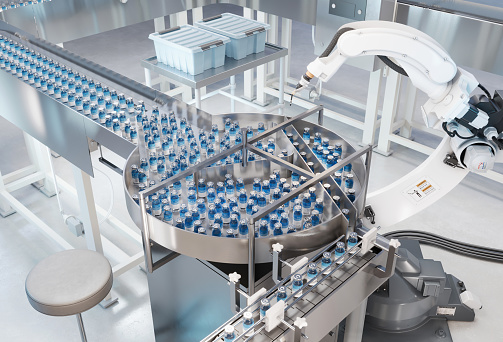alvarez/E+ via Getty Images
LianBio (NASDAQ:LIAN) was a rising star of the Chinese pharmaceutical scene but the drugs startup has flamed out just four years after its launch.
The biotech’s abbreviated lifespan underscores the challenges and costs of bringing novel drugs to the market, even with financial backing and big ambitions.
The company’s mission was to obtain the rights to drugs in the latter stages of development and make them available to the mass Chinese market. LianBio was the poster child of this so-called “licensing in” model, obtaining financing of $310 million just two months after the company was set up in 2020.
A year later it went public on the Nasdaq, raising another $325 million. But after a strategic review of its business, LianBio announced last Tuesday that it would wind down most of its operations and delist from Nasdaq by the end of this year. It then plans to wrap up its remaining business over the next three years.
In its announcement, LianBio said it would sell its remaining pipelines, phase out ongoing clinical trials and pay a special dividend of $4.80 per share totaling about $528 million on or around March 11. Profits would be distributed to shareholders once the sale of the remaining assets is completed.
The company plans to lay off more than 50 employees, or about 50% of its workforce, in the first quarter but said it would retain a core staff for now to ensure an orderly winddown and to help maximize the value of the remaining assets. The business would finally be dissolved in the first half of 2027.
The company plans to submit a delisting application to the U.S. Securities and Exchange Commission on or around March 8, with a view to quitting the Nasdaq around March 18. However, some investors still saw a profit opportunity in the company’s exit strategy. On the day of the announcement, LianBio’s shares soared 18.8% to close at $4.80, the level of the proposed special dividend.
However, investors who bought in to the original IPO would be left with a 70% loss. LianBio listed in November 2021 at an offer price of $16. The stock fell 14.4% on the debut day and has been on a downward spiral since then. It hovered around $3 for a long period after May 2022, hitting a $1.33 low in October last year with a market capitalization of just $140 million.
In its most recent earnings report, LianBio posted a net loss of $69.7 million for the first three quarters of 2023, compared with a $92 million shortfall for the same period a year earlier, and the company still held cash reserves of $252 million. The combination of low market capitalization and good cash flow attracted the attention of “vulture capitalist” TANG-Capital in early December last year. The hedge fund made a buyout offer for 80% of the net proceeds from the company’s projects at $4.30 per share, but required LianBio to guarantee no less than $515 million in cash and cash equivalents remaining on its books at the time of delivery. Ultimately, the LianBio board rejected the offer as undervaluing the company.
Slow market progress
The $4.80 per share special dividend promised by LianBio exceeds the amount offered by TANG-Capital for the drug company, which was founded and led by U.S. private equity fund Perceptive Advisors. The life sciences investor set up LianBio in the hope of introducing high-quality and clinically proven medicines from overseas into China to meet the needs of the world’s second-largest pharmaceutical market.
And LianBio got off to a promising start, licensing in nine products from other drug developers before listing its shares in 2021. The drugs targeted conditions including cardiovascular and renal problems, cancers, eye disorders, inflammation, and respiratory illnesses. Most of the acquired pipelines were already in the late clinical stages, leaving the company to conclude the trials and commercially launch the products on the Chinese mainland. Peers such as Everest Medicines (1952.HK) and Zai Lab (ZLAB; 9688.HK) adopted a similar model.
But four years after it was founded, LianBio had still not managed to cross the commercial threshold with any product, which could reflect a lack of inhouse R&D capability. Of the nine pipelines, Mavacamten made the fastest progress as a drug for heart disease. It had already completed Phase II clinical trials before being acquired from MyoKardia in 2020 and was approved for marketing in the U.S. in April 2022. But despite its global progress, the drug did not complete Phase III clinical trials in China until August last year.
After the drug gained marketing approval, LianBio faced the prospect of investing large sums to build a commercialization team. Instead, the company licensed the rights in China to Bristol Myers Squibb (BMY) in October last year for $350 million. Minus a $40 million payment for obtaining the drug, LianBio earned a net $310 million from the deal. LianBio acquired another drug candidate for the respiratory virus RSV in 2021 with a $14 million down payment. That drug, Sisunatovi, was sold on to Pfizer (PFE) in 2022 for an initial $20 million and $135 million in milestone payments.
The deals show LianBio was adept at selecting promising drugs and acting as an industry middleman, but they also highlight its shortcomings as a drugs producer. Among companies with a similar business model, Everest Medicines, incubated by biopharmaceutical investment fund C-Bridge Capital, already has several star products on the market, including Xerava, a potent antimicrobial drug, and Nefecon, the world’s first targeted drug for the kidney disease IgA nephropathy.
Therefore, investors can draw an important lesson from LianBio’s short lifecycle: the licensing-in model is perfectly viable if companies are able to spot good drug candidates and follow up with R&D and marketing expertise.
Disclosure: None.



